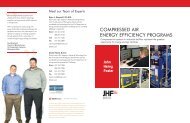The Turbo Air® 3000 Centrifugal Compressor Compressor Handbook
The Turbo Air® 3000 Centrifugal Compressor Compressor Handbook
The Turbo Air® 3000 Centrifugal Compressor Compressor Handbook
Create successful ePaper yourself
Turn your PDF publications into a flip-book with our unique Google optimized e-Paper software.
<strong>The</strong> <strong>Turbo</strong> Air <strong>3000</strong> <strong>Centrifugal</strong> <strong>Compressor</strong> Operator’s Manual<br />
· Tubes <strong>The</strong> tubes must be cleaned using a series of brushes (in the case of the intercoolers and<br />
aftercooler) or a rod (in the case of the oil cooler) and then given a thorough soaking with a<br />
commercial descaling agent such as RydlymeÒ.<br />
· Fins <strong>The</strong> aluminum fins of the intercoolers and aftercooler must be cleaned using a high pressure<br />
air, steam, or water spray and then given an additional soaking with a commercial cleaning agent<br />
such as Coil BoilÒ.<br />
Instructions for cleaning both the water and air sides of the intercoolers and aftercooler are included<br />
here, along with instructions for cleaning the oil cooler.<br />
Refer to Section Seven, Parts and Service, for complete information about ordering specified commercial<br />
products required for this procedure.<br />
Intercoolers and Aftercooler Cleaning<br />
Water Side:<br />
Use a gun-cleaning or tube-cleaning kit for this procedure. Such commercially available kits come with<br />
a selection of brushes in varying sizes, making them ideally suited for this purpose. <strong>The</strong> recommended<br />
range of brush sizes is from 1/4” to 3/8” (6 to 10 mm), to allow the user to begin cleaning with a<br />
smaller size brush and then progress to the largest size.<br />
1. Shut down the compressor and exhaust all air pressure. Lockout the main motor starter and close<br />
the system block valve.<br />
2. Shut off the cooling water and remove the supply piping.<br />
3. Drain the coolant, and then remove the intercooler headers.<br />
4. Remove the intercoolers from the cooler cavity. (Refer to Figure 5—3.)<br />
5. Inspect the cooler casings for corrosion. If necessary, clean the casings.<br />
5—18



